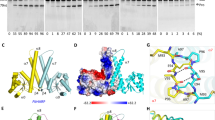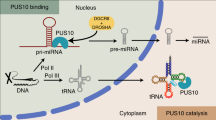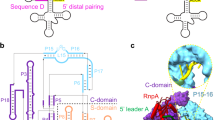Abstract
La proteins bind pre-tRNAs at their UUU-3′OH ends, facilitating their maturation. Although the mechanism by which La binds pre-tRNA 3′ trailers is known, the function of the RNA binding β-sheet surface of the RNA-recognition motif (RRM1) is unknown. How La dissociates from UUU-3′OH–containing trailers after 3′ processing is also unknown. Here we show that La preferentially binds pre-tRNAs over processed tRNAs or 3′ trailer products through coupled use of two sites: one on the La motif and another on the RRM1 β-surface that binds elsewhere on tRNA. Two sites provide stable pre-tRNA binding, whereas the processed tRNA and 3′ trailer are released from their single sites relatively fast. RRM1 loop-3 mutations decrease affinity for pre-tRNA and tRNA, but not for the UUU-3′OH trailer, and impair tRNA maturation in vivo. We propose that RRM1 functions in activities that are more complex than UUU-3′OH binding. Accordingly, the RRM1 mutations also impair an RNA chaperone activity of La. The results suggest how La distinguishes precursor from product RNAs, allowing it to recycle onto a new pre-tRNA.
This is a preview of subscription content, access via your institution
Access options
Subscribe to this journal
Receive 12 print issues and online access
$189.00 per year
only $15.75 per issue
Buy this article
- Purchase on Springer Link
- Instant access to full article PDF
Prices may be subject to local taxes which are calculated during checkout






Similar content being viewed by others
Accession codes
References
Maraia, R.J. & Intine, R.V. Recognition of nascent RNA by the human La antigen: conserved and diverged features of structure and function. Mol. Cell. Biol. 21, 367–379 (2001).
Wolin, S.L. & Cedervall, T. The La protein. Annu. Rev. Biochem. 71, 375–403 (2002).
Maraia, R.J. & Bayfield, M.A. The La protein-RNA complex surfaces. Mol. Cell 21, 149–152 (2006).
Teplova, M. et al. Structural basis for recognition and sequestration of UUU-OH 3′-termini of nascent RNA pol III transcripts by La, a rheumatic disease autoantigen. Mol. Cell 21, 75–85 (2006).
Goodier, J.L., Fan, H. & Maraia, R.J. A carboxy-terminal basic region controls RNA polymerase III transcription factor activity of human La protein. Mol. Cell. Biol. 17, 5823–5832 (1997).
Alfano, C. et al. Structural analysis of cooperative RNA binding by the La motif and central RRM domain of human La protein. Nat. Struct. Mol. Biol. 11, 323–329 (2004).
Dong, G., Chakshusmathi, G., Wolin, S.L. & Reinisch, K.M. Structure of the La motif: a winged helix domain mediates RNA binding via a conserved aromatic patch. EMBO J. 23, 1000–1007 (2004).
Kenan, D.J. & Keene, J.D. La gets its wings. Nat. Struct. Mol. Biol. 11, 303–305 (2004).
Kotik-Kogan, O., Valentine, E.R., Sanfelice, D., Conte, M.R. & Curry, S. Structural analysis reveals conformational plasticity in the recognition of RNA 3′ ends by the human La protein. Structure 16, 852–862 (2008).
Curry, S. & Conte, M.R. A terminal affair: 3′-end recognition by the human La protein. Trends Biochem. Sci. 31, 303–305 (2006).
Aigner, S. et al. Euplotes telomerase contains an La motif protein produced by apparent translational frameshifting. EMBO J. 19, 6230–6239 (2000).
Stone, M.D. et al. Stepwise protein-mediated RNA folding directs assembly of telomerase ribonucleoprotein. Nature 446, 458–461 (2007).
He, N. et al. A La-related protein modulates 7SK snRNP integrity to suppress P-TEFb-dependent transcriptional elongation and tumorigenesis. Mol. Cell 29, 588–599 (2008).
Krueger, B.J. et al. LARP7 is a stable component of the 7SK snRNP while P-TEFb, HEXIM1 and hnRNP A1 are reversibly associated. Nucleic Acids Res. 36, 2219–2229 (2008).
Aigner, S., Postberg, J., Lipps, H.J. & Cech, T.R. The Euplotes La motif protein p43 has properties of a telomerase-specific subunit. Biochemistry 42, 5736–5747 (2003).
Yoo, C.J. & Wolin, S.L. The yeast La protein is required for the 3′ endonucleolytic cleavage that matures tRNA precursors. Cell 89, 393–402 (1997).
Intine, R.V.A. et al. Transfer RNA maturation is controlled by phosphorylation of the human La antigen on serine 366. Mol. Cell 6, 339–348 (2000).
Huang, Y., Bayfield, M.A., Intine, R.V. & Maraia, R.J. Separate RNA-binding surfaces on the multifunctional La protein mediate distinguishable activities in tRNA maturation. Nat. Struct. Mol. Biol. 13, 611–618 (2006).
Chakshusmathi, G., Kim, S.D., Rubinson, D.A. & Wolin, S.L.A. La protein requirement for efficient pre-tRNA folding. EMBO J. 22, 6562–6572 (2003).
Copela, L.A., Chakshusmathi, G., Sherrer, R.L. & Wolin, S.L. The La protein functions redundantly with tRNA modification enzymes to ensure tRNA structural stability. RNA 12, 644–654 (2006).
Blackburn, E.H. The end of the (DNA) line. Nat. Struct. Biol. 7, 847–850 (2000).
Schroeder, R., Barta, A. & Semrad, K. Strategies for RNA folding and assembly. Nat. Rev. Mol. Cell Biol. 5, 908–919 (2004).
Belisova, A. et al. RNA chaperone activity of protein components of human Ro RNPs. RNA 11, 1084–1094 (2005).
Hendrick, J.P., Wolin, S.L., Rinke, J., Lerner, M.R. & Steitz, J.A. Ro small cytoplasmic ribonucleoproteins are a subclass of La ribonucleoproteins: further characterization of the Ro and La small ribonucleoproteins from uninfected mammalian cells. Mol. Cell. Biol. 1, 1138–1149 (1981).
Maraia, R.J. & Intine, R.V. La protein and its associated small nuclear and nucleolar precursor RNAs. Gene Expr. [review] 10, 41–57 (2002).
Nashimoto, M., Nashimoto, C., Tamura, M., Kaspar, R.L. & Ochi, K. The inhibitory effect of the autoantigen La on in vitro 3′ processing of mammalian precursor tRNAs. J. Mol. Biol. 312, 975–984 (2001).
Hopper, A.K. & Phizicky, E.M. tRNA transfers to the limelight. Genes Dev. 17, 162–180 (2003).
Phizicky, E.M. Have tRNA, will travel. Proc. Natl. Acad. Sci. USA 102, 11127–11128 (2005).
Haeusler, R.A. & Engelke, D.R. Spatial organization of transcription by RNA polymerase III. Nucleic Acids Res. 34, 4826–4836 (2006).
Pfeifle, J., Anderer, F.A. & Franke, M. Multiple phosphorylation of human SS-B/La autoantigen and its effect on poly(U) and autoantibody binding. Biochim. Biophys. Acta 928, 217–226 (1987).
Huang, Y., Intine, R.V., Mozlin, A., Hasson, S. & Maraia, R.J. Mutations in the RNA polymerase III subunit Rpc11p that decrease RNA 3′ cleavage activity increase 3′-terminal oligo(U) length and La-dependent tRNA processing. Mol. Cell. Biol. 25, 621–636 (2005).
Draper, D.E., Grilley, D. & Soto, A.M. Ions and RNA folding. Annu. Rev. Biophys. Biomol. Struct. 34, 221–243 (2005).
Setzer, D.R. Measuring equilibrium and kinetic constants using gel retardation assays. Methods Mol. Biol. 118, 115–128 (1999).
Ohndorf, U.M., Steegborn, C., Knijff, R. & Sondermann, P. Contributions of the individual domains in human La protein to its RNA 3′-end binding activity. J. Biol. Chem. 276, 27188–27196 (2001).
Horke, S., Reumann, K., Schweizer, M., Will, H. & Heise, T. Nuclear trafficking of La protein depends on a newly identified NoLS and the ability to bind RNA. J. Biol. Chem. 279, 26563–26570 (2004).
Intine, R.V., Dundr, M., Misteli, T. & Maraia, R.J. Aberrant nuclear trafficking of La protein leads to disordered processing of associated precursor tRNAs. Mol. Cell 9, 1113–1123 (2002).
Van Horn, D.J., Yoo, C.J., Xue, D., Shi, H. & Wolin, S.L. The La protein in Schizosaccharomyces pombe: a conserved yet dispensable phosphoprotein that functions in tRNA maturation. RNA 3, 1434–1443 (1997).
Bayfield, M.A., Kaiser, T.E., Intine, R.V. & Maraia, R.J. Conservation of a masked nuclear export activity of La proteins and its effects on tRNA maturation. Mol. Cell. Biol. 27, 3303–3312 (2007).
Wang, Z., Luo, T. & Roeder, R.G. Identification of an autonomously initiating RNA polymerase III holoenzyme containing a novel factor that is selectively inactivated during protein synthesis inhibition. Genes Dev. 11, 2371–2382 (1997).
Fairley, J.A. et al. Human La is found at RNA polymerase III-transcribed genes in vivo. Proc. Natl. Acad. Sci. USA 102, 18350–18355 (2005).
French, S.L. et al. Visual analysis of the yeast 5S rRNA gene transcriptome: regulation and role of La protein. Mol. Cell. Biol. 28, 4576–4587 (2008).
Anderson, J. et al. The essential Gcd10p-Gcd14p nuclear complex is required for 1-methyladenosine modification and maturation of initiator methionyl-tRNA. Genes Dev. 12, 3650–3662 (1998).
Calvo, O. et al. GCD14p, a repressor of GCN4 translation, cooperates with Gcd10p and Lhp1p in the maturation of initiator methionyl-tRNA in Saccharomyces cerevisiae. Mol. Cell. Biol. 19, 4167–4181 (1999).
Johansson, M.J. & Bystrom, A.S. Dual function of the tRNA(m5U54)methyltransferase in tRNA maturation. RNA 8, 324–335 (2002).
Nishikura, K. & De Robertis, E.M. RNA processing in microinjected Xenopus oocytes. Sequential addition of base modifications in the spliced transfer RNA. J. Mol. Biol. 145, 405–420 (1981).
Maglott, E.J., Deo, S.S., Przykorska, A. & Glick, G.D. Conformational transitions of an unmodified tRNA: implications for RNA folding. Biochemistry 37, 16349–16359 (1998).
Maris, C., Dominguez, C. & Allain, F.H. The RNA recognition motif, a plastic RNA-binding platform to regulate post-transcriptional gene expression. FEBS J. 272, 2118–2131 (2005).
Mikulecky, P.J. et al. Escherichia coli Hfq has distinct interaction surfaces for DsrA, rpoS and poly(A) RNAs. Nat. Struct. Mol. Biol. 11, 1206–1214 (2004).
Rajkowitsch, L. & Schroeder, R. Dissecting RNA chaperone activity. RNA 13, 2053–2060 (2007).
Acknowledgements
We thank D. Setzer for advice, protocols and RNA binding data analysis tools, M. Nashimoto (Niigata University of Pharmacy and Applied Life Sciences) for the human tRNAArgACG gene and R. Schroeder (University of Vienna) for cis-splicing intron DNA. We thank D. Setzer, D. Engelke and M. Teplova for comments. This work was supported by the Intramural Research Program of the US National Institute of Child Health and Human Development, National Institutes of Health.
Author information
Authors and Affiliations
Contributions
M.A.B. performed all experiments; R.J.M. and M.A.B. designed the study and analyzed the data; R.J.M. wrote the paper with editing by M.A.B.
Note: Supplementary information is available on the Nature Structural & Molecular Biology website.
Corresponding author
Supplementary information
Supplementary Text and Figures
Supplementary Figures 1–8 (PDF 4149 kb)
Rights and permissions
About this article
Cite this article
Bayfield, M., Maraia, R. Precursor-product discrimination by La protein during tRNA metabolism. Nat Struct Mol Biol 16, 430–437 (2009). https://doi.org/10.1038/nsmb.1573
Received:
Accepted:
Published:
Issue Date:
DOI: https://doi.org/10.1038/nsmb.1573
This article is cited by
-
Cell surface-bound La protein regulates the cell fusion stage of osteoclastogenesis
Nature Communications (2023)
-
Altered tRNA processing is linked to a distinct and unusual La protein in Tetrahymena thermophila
Nature Communications (2022)
-
1H, 13C and 15N backbone and side-chain resonance assignment of the LAM–RRM1 N-terminal module of La protein from Dictyostelium discoideum
Biomolecular NMR Assignments (2015)



